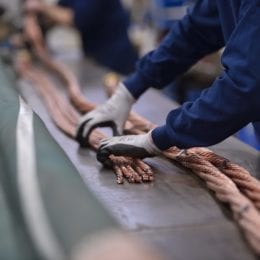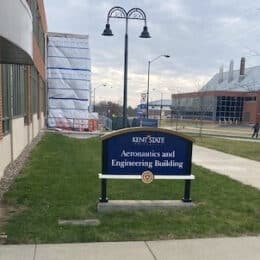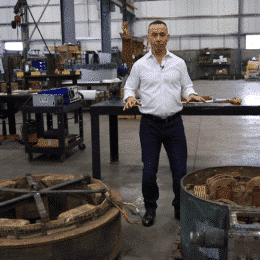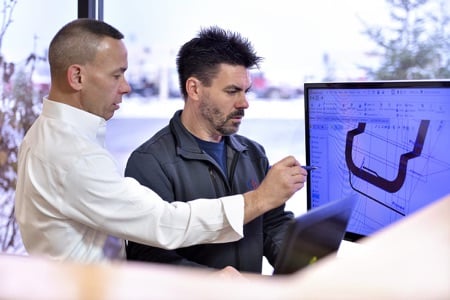Engineering FAQs
Water-Cooled Power Cables and Electrical Components
Eager to solve problems, I²r POWER collaborates to ensure you have products meeting your exact needs. Using more than 75 years of combined engineering experience, our strong technical team is more than willing to help you unravel and solve your product challenges.
Get answers to frequently asked questions on water-cooled power cables and other electrical components here, or contact us for more information on I²r POWER cables specifically. We’re happy to answer your questions or provide you with a customized estimate!
What happens during an inspection of used equipment for repair?
Proper inspection of any equipment begins with determining the history of the equipment, observing apparent cause of failure, performing applicable testing, and completing photo documentation and drawings as required. All of this is followed by consultation with the customer. At this point, determining the best course of action is established, costs are obtained, and a detailed quotation is provided to the customer. We offer no-cost, no-obligation inspections. Let’s talk!
What are voltage losses and watt losses?
Voltage is the amount of potential difference of charge between two points in an electric field. Power cable voltage loss occurs when current flows across conductor resistance. Electrical power is measured in watts. Watts are a unit of power expressing the rate at which energy or current flows. Watt loss is created by the resistance of the conductor to the current flow of electrons.
How do I know when to pull the cable from service?
When internal conductor packages of water-cooled power cables begin to break down in a melting application, often the counter intuitive thing happens—adjacent cables on the same phase begin to operate warmer due to the need to carry more current.
Today’s control systems typically measure current, voltage and output coolant temperatures. Increased voltage drop, higher current readings and warmer coolant return indicate the beginning of cable failure. Visual inspection of the thermal protective covering, chafing protection, and non-conductive cover hoses is critical for both routine maintenance and determining whether to replace the cable.
Induction Power Cables
Engineered for electrical efficiency and hand-built using top-grade materials, I2r POWER technicians craft your high-current induction cables to maximize power transmission. Learn more.
EAF/LMF Power Cables
Optimal power transmission and electrical efficiency improvements are engineered into every Electric Arc Furnace (EAF) and Ladle Metallurgy Furnace (LMF) water-cooled cable at I2r POWER. No matter your high-current application or demanding production environment, I2r POWER technicians hand-craft your water-cooled power cable for reliability and longevity. Learn more.
How do stirrers work?
Non-contact electromagnetic stirring improves the homogeneity of molten and cast alloys improving efficiency, quality and metallurgy. EMS stirrers for steel applications produce very low frequency, high amplitude magnetic fields to agitate steel when molten.
Electromagnetic stirring applications include stirring in the ladle while steel alloy recipes are being created or stirring in continuous cast steel for alloy integrity as the steel casting cools.
How do I prevent EAF cables from kinking?
Maintaining efficient coolant flow in a water-cooled Electric Arc Furnace (EAF) power cable is imperative. Not only can kinking water-cooled power cables be very damaging to the power cable, but it can damage additional equipment components influenced by the coolant stream. Additionally, excessive hose kinks reduce conductor and hose cover life.
Prevention begins with front end EAF power cable design–the first step to mitigate or reduce hose collapse. Designing a proper power cable includes determining the best geometric mean radius (GMR), and implementing good core design factoring in size of the conductor, number of conductors and assembly helix. Awareness of pinch points and maintaining recommended minimum bend radius from the factory play an important role, as well.
How long will my power cable last?
Many Electric Arc Furnace (EAF) and Ladle Metallurgy Furnace (LMF) operators will change their EAF/LMF power cables every three years, often replacing cables on one phase per year. A general rule for induction melting power cables is about five years. Regardless of the furnace system, application and maintenance practices are key factors in the life of a power cable.
EAF/LMF Power Cables
Optimal power transmission and electrical efficiency improvements are engineered into every Electric Arc Furnace (EAF) and Ladle Metallurgy Furnace (LMF) water-cooled power cable at I2r POWER. No matter your high-current application or demanding production environment, I2r POWER technicians hand-craft your water-cooled power cable for reliability and longevity. Learn more.
Induction Power Cables
Engineered for electrical efficiency and hand-built using top-grade materials, I2r POWER technicians craft your high-current induction cables to maximize power transmission. Learn more.
How do I know if my power cable goes bad?
Melt systems, whether AC or DC, vary greatly in their respective diagnostic capabilities. If however, the melt system’s power cables and/or bus assembly is weakening, conductor resistance will increase, and full power cannot be achieved. Elevated coolant temperatures in the system can be an indication of increased resistance as well. In such cases, we recommend removing your melt system power cable for further inspection/evaluation.
What do I do if my furnace cable is leaking?
Your safety and the stewardship of the melt heat is paramount! Do not run your melt furnace system with a leaking water-cooled power cable installed. Remove the power cable from service. We recommend a thorough professional inspection to determine leak cause(s) and course of repair.
How do I size my cable?
In order to size your cable, you should first measure the length required to make the connection between the power source and the heating/melting device.
Next, calculate the amount of copper conductor required to carry the current. A water-cooled cable, and/or bus, needs approximately 350 MCM of copper cross-section for every 1,000 amps of current. Conversely, an air-cooled system requires approximately 3 times the copper conductor to carry the same current. Induction-based melt systems must consider the operating frequency into account when determining the optimal conductor cross-section.
Related Videos
Have additional questions?
We’re happy to help answer them. Let's talk today to get more information or to request a quote.






